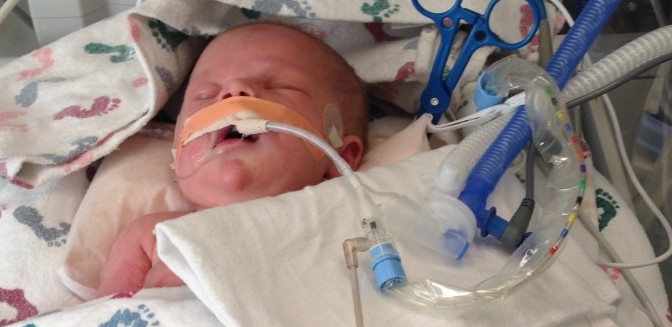If you missed any of the previous posts about Isabel’s birth you can check them out here:
Isabel is now a week old and is getting ready to have her first major procedure done. The doctor that was going to perform the Heart Catheterization came in and discussed the details of the procedure. They took her back and we waited. It it only took about an hour but it was one of the longest hours of my life.
The procedure was successful. We now know what Isabel’s anatomy looks like. Isabel was born with Pulmonary Atresia (PA), a Ventral Septal Defect (VSD), Major Aorto-Pulmonary Collateral Arteries (MAPCAs) and a Right Aortic Arch (RAA). Holy poop thats a mouth full. Honestly, I had to ask Jen for the terms because she is so much better at remembering the technical stuff. For those of you that my not have been paying attention during “Super Specific Heart Stuff 101”, here is a quick overview of what is going on.
Pulmonary Atresia
In Isabel’s case this means that she does not have a pulmonary valve and has a very small main pulmonary artery that does not contain any blood flow. The pulmonary artery supplies un-oxygenated blood to the lungs from the right ventricle. She does have both the right and left Pulmonary Arches that are providing some blood to the lungs but, they are being supplemented by the MAPCAs, described below, and not the Pulmonary Artery.
Ventral Septal Defect
Isabel has a hole between the right and left ventricles of her heart. Oxygenated blood is mixing with non-oxygenated blood and then being pumped through the Aorta to the rest of her body. This causes the oxygen level in her blood (~80 %) to be lower than normal (between 95-98 %).
Major Aorto-Pulmonary Collateral Arteries
This is cool and one of the reasons I absolutely love the human body. As Isabel grew her body realized that it was going to need to get blood to her lungs. It wasn’t going to get there through the pulmonary valve since she doesn’t have one, so the body created MAPCAs in order to get the blood where it needed to go. She has many small arteries that move the blood from the Aorta to the Pulmonary Arches and the lungs. These are what kept my daughter alive! Mind Blown…
Right Aortic Arch
Most people have an Aortic Arch that goes up and to the left supplying the blood to the head and arms and then it goes behind the heart and down to supply the legs and other organs like the liver and kidneys. Isabel’s actually goes up and to the right but still supplies the blood to the same parts of the body. There are people that live with a RAA and never know it.
The Next Step
Another good thing we found from the Cath was that they were able stop the Prostaglandin they had started her when we first arrived because it was not the Patent Ductus Arteriosus (PDA) that was keeping her alive like they thought when we arrived. The PDA connects the Pulmonary Artery to the Aorta while the baby is still in utero. Normally after the first few breaths the PDA closes forcing blood to the lungs. Prostaglandin’s keep the PDA open.
Now knowing Isabel’s anatomy, the doctors are able to start planning her surgery. For the next few days we are waiting to hear from the surgeon about the options and when they schedule the surgery.

One thought on “The First Catheterization”